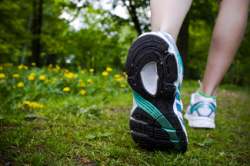 With spring just around the corner, now that you might have a little more of a ‘spring’ in your step, this exercise builds on some of the previous relaxation exercises in a rather more active way. Believe it or not, walking promotes our relaxation response; any physical exercise produces natural, feel-good chemicals in your brain. It need not be a long walk – even 10 minutes once or twice a day makes a positive difference. Building on this distance can enhance the relaxation response and turn walking into something you can add to your relaxation repertoire in order to promote better physical and mental health overall. With practice, walking can become part of your routine of simply going to work, going home after work or, if you have a particularly stressful day, taking 10 minutes to step outside and feel refreshed.
With spring just around the corner, now that you might have a little more of a ‘spring’ in your step, this exercise builds on some of the previous relaxation exercises in a rather more active way. Believe it or not, walking promotes our relaxation response; any physical exercise produces natural, feel-good chemicals in your brain. It need not be a long walk – even 10 minutes once or twice a day makes a positive difference. Building on this distance can enhance the relaxation response and turn walking into something you can add to your relaxation repertoire in order to promote better physical and mental health overall. With practice, walking can become part of your routine of simply going to work, going home after work or, if you have a particularly stressful day, taking 10 minutes to step outside and feel refreshed.
Start with becoming aware of the pace of your walking – not doing anything to change it, but just noticing your pace, the lightness or heaviness of your step, the temperature around you, your own temperature, how your clothes feel as you walk, the sounds around you, the sound of your step, the weather, what you can see around you as you walk, and the detail of things in the near, middle and far distance, including their colour, their shape and the sense you get of their texture. You can notice, too, what thoughts and emotions you are experiencing – your own weather pattern, as it were. Notice all these things with a certain sense of curiosity rather than just operating on automatic pilot.
Then tune in with your breathing – its rate and whether you are breathing more in the upper or the lower chest. Shallow breathing in the upper chest is most likely to mean that you are more anxious or stressed than relaxed. A certain amount of adrenaline is good – it helps you perform well, sharpens your focus and gets you going generally, of course. This exercise is about noticing levels of anxiety and stress and levels of relaxation, and it’s about being aware of how we are feeling so we can take corrective action to control anxiety or stress if they are reaching higher levels than we need to motivate ourselves and work well. Part of this process is also to ensure that we are building sufficient time into the day to pay attention to ourselves – again, rather than being on automatic pilot.
Slowly focus on slowing down the pace of breathing if you need to, lowering the in-breath right down to the bottom of the lungs, breathing diaphragmatically. Just spend some time maintaining that focus, maybe 20 paces or more, counting in your head as you do so. Even if you need to maintain adrenaline levels as you walk, this will give you a sharper sense of focus.
Once you have reached a steady momentum with that breathing, you can notice how your arms are moving in step with your pace. How relaxed are the arms? If you detect any tension in them, you can allow them to move a little more freely and notice the change as they move differently. As part of this, you can deliberately tense your hands, hold for a count of 10 and then let go. Again, notice the difference between the tension and the relaxation when you let go.
Above all, enjoy the walk!

